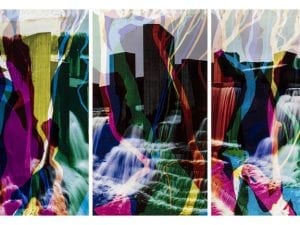Rather than one single working style, Val Wecerka’s practice seeks to cure a longstanding curiosity with both form and content, consistently striving to create something new. One of the Longlisted Artists from the Aesthetica Art Prize, Wecerka transports audiences through experimentation. We catch up with her to discuss the stimuli behind her diverse oeuvre.
A: Rather than one single working style, your practice covers an entire spectrum of topics and forms. Do you think it’s important for artists to be diverse in what they create or how they experiment?
VW: Everything hangs on the decision of the artist, if he/she is looking for unique challenges. Some artists find one working style and develop there work, however, my practice covers an entire spectrum of topics and forms, from figurative to abstract and ornamental, holding a keen interest in experimenting with different materials to express ideas.
A: Do you have a favourite style or technique to work in?
VW: No, I try to reinvent my work. When I start a new topic I try to take my work as one in progress; I am always in search for new ideas because I hold a sense of curiosity towards art.
A: Your works vary in their medium and how they approach idea or inspiration, for example (un)written letters, questions human communication. Could you talk about the processes behind your work?
VW: It started 1992, when I crossed the border from Bulgaria to Austria. I was totally alone and as I cannot speak German fluently, the only way for me to communicate was by writing letters to my family. This was what began the theme of “borders”. But now, 24 years later, the topic of borders seems more relevant than ever.
A: Does the idea come first, or are you inspired by experimenting in a certain medium?
VW: Sometimes the idea comes first or sometimes a theme, but I also get inspired by experimenting.
A: Your Possible Geometry series works on a range of textures, layers and palettes. How do these works speak to you?
VW: I try to create works that project something onto their observer, or in other words make a scenario that fascinates the viewer.
A: How do you think that colour operates in your works – is it attached to emotion or is it more to create depth, like in your most recent multi-tonal works?
VW: In each case, it depends on the characteristics of the work and my specific mood.
A: How important do you think shapes are in terms of stimulating our minds?
VW: I would say very important, as we are exposed to them constantly and for that reason we are consistently influenced by shapes and noise.
A: Could you tell us about your future projects?
VW: Presently, I’m involved in a group exhibition at the Royal Scottish Academy.
To find more examples of her work visit www.valwecerka.at
For more information about the longlisted artwork for the Aesthetica Art Prize www.aestheticamagazine.com
Credits:
1. A New Page (2016). Courtesy of the artist.
2. The Curtain (2016). Courtesy of the artist.
3. Untitled (2016). Courtesy of the artist.



